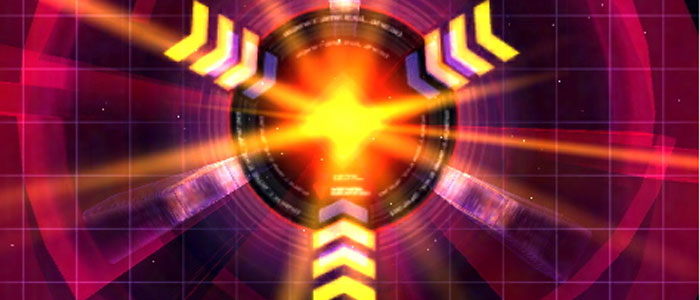A space age top-down shooter in the vein of Geometry Wars and Asteroids, Circuit Strike.One is a startling overachiever. You maneuver an aircraft through rooms seeking out and destroying red Shield Generators in order to expose the Data.Core at the level’s center. Once made vulnerable it transforms from impermeable barrier to deadly force, so steer clear. A 30 second countdown begins, all the time you have to defend yourself and destroy the Data.Core before it’s G.O. so you can advance to the next level. All this is explained in a series of instructional screens before you dive into the first level. However, it’s too much information at one time and in too unreadable a font. After a few screens of squinting I figured I’d just wing it.
There are three control options, with Basic controls recommended for the beginner set. They are actually pretty challenging, with a left side control pad of sorts for direction and “buttons” on the right to fire or use thrusters (the latter are imprecise at best). On the opposite end of the spectrum are Advanced controls, all too true to their name. Like Goldilocks, I found myself happiest in the middle: a Dual Stick option was just right. Smoother and more intuitive I was able to glide freely, if a bit recklessly, while firing, certainly a recipe for success.
The style of the game is exceptional, and the explosions and effects will push your device to its limit without any detectable slow down. An added treat is that the 3D main menu can be controlled with the accelerometer; very cool and gives the game an added note of polish. The environments are all circuitry inspired, and traversing rooms is as simple as gliding through the walls. As you warp through to adjoining rooms the color motifs and music change. At the beginning of each level you are shown a schematic with the locations of the generators. One great gleam of polish shines here: you can double tap through all these screens as you enter a stage and cruise through menus, saving valuable seconds of gaming time. I really appreciate that the developers recognize that game time is precious, and it’s a delight to skip over necessary but repetitive information in a game where replaying levels is requisite.
As an enemy is loaded into the matrix a blinking colored grid will warn of the impending arrival of the polygonal ship. The variety of enemy ships attack kamikaze style, and each shield generator is guarded by a turret. If you feel like building up some steady points you can linger in one place firing leisurely at the incoming ships, occasionally collecting the green stuff they leave behind dubbed “ghost data” to fuel Bullet Time. Shaking the device activates Bullet Time and triggers a few seconds of invulnerability tempered by slow motion.
There are three difficulties and you are able to start on Easy with the tougher modes as unlockables. It is a challenging game, so come to terms with your gaming mortality. When you do lose one of your three lives, an Internet meme pops up to taunt you like “pwned” or “Epic Phail”. I was dubbed “Id!ot” after cruising into an enemy ship. Spot on, fellas.
CS.One remains taut with urgency throughout. The techno score from DJ Vitamin Devo and Bianca Dino is the perfect accompaniment, amplifying the intensity and taking cues from the action onscreen. Levels begin with a dial-up modem sound so hardwired into my early Internet memory it gives me the uneasy feeling I am back in my parents’ home, trying to get online after they’ve gone to bed. The online leaderboard is very competitive. Easily accessible in game, it handily displays the difference between your place on the leaderboards and the person above you as well as the number one title holder.
I don’t like to count difficulty as a con, so as it does limit the game’s audience take heed: this is a gamer’s game. Your resources may seem meagre, but skill, strategy and focus are rewarded. It’s too bad that in all this truly amazing polish the weirdest things crop up to dampen the fun. CS.One is just a little off-kilter that way: a menu that is an accelerometer enabled 3D fun-fest, but you can’t read the text; mesmerizing onscreen action and score paired with murky control schemes. If you can overcome these obstacles, however, you will be treated to a singular mobile gaming experience.
